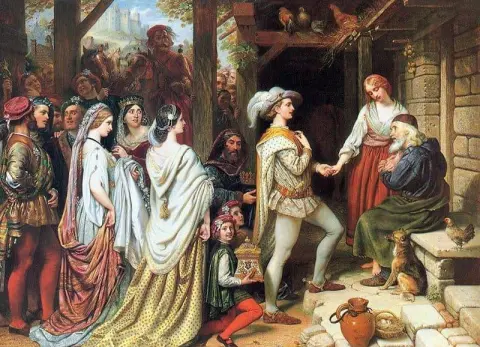

Hand painted reproductions of Charles West Cope
Charles West Cope (1811–1890): Renowned English History Painter and Artist of the Victorian Era
Charles West Cope was an influential English painter of the 19th century, celebrated for his contributions to historical painting. His works, which are imbued with dramatic storytelling, realism, and academic precision, have made a significant mark on the history of British art. Cope’s ability to bring historical narratives to life through vivid and accurate depictions of the past helped solidify his place as one of the leading painters in Victorian England.
Early Life and Education
Born on 15th March 1811 in Yorkshire, England, Charles West Cope grew up with a deep interest in art and drawing. His early talent was recognized by his family, and he was sent to London to study at the prestigious Royal Academy of Arts. Cope's formal education there provided him with a strong foundation in the classical traditions of painting, which he would later combine with a penchant for historical and dramatic subjects.
At the Royal Academy, Cope was influenced by a range of prominent tutors and fellow students, particularly the academic tradition that emphasized technique, composition, and historical themes. By the time he graduated, Cope had already developed a distinctive style that was grounded in realism and an academic approach to the human form.
Artistic Development and Style
Charles West Cope became known primarily for his historical paintings, which reflected his deep interest in British history, mythology, and literature. He was deeply influenced by the Neo-Classical tradition, which emphasized idealized depictions of the human figure and a focus on classical antiquity. However, Cope also embraced elements of the Romantic movement, injecting his works with emotional intensity and dramatic compositions.
Cope’s style was characterized by his attention to detail, his masterful handling of light and shadow, and his ability to create powerful narrative moments in his paintings. His work was highly academic, yet it conveyed a sense of emotional depth and psychological complexity. His historical subjects were often populated by figures drawn from English history, mythology, or literature, all depicted with a sense of grandeur and precision.
In terms of technique, Cope’s use of color was often restrained, focusing on creating a realistic sense of light and texture. His careful attention to detail in costume and setting reflected his research into the historical periods he portrayed, and his works often had an almost cinematic quality, drawing the viewer into the narrative.
Themes and Significance
One of the most notable aspects of Cope’s work is his focus on historical subjects. His paintings often depicted dramatic moments from English history, including key events, battles, and moments of political or social change. These works were more than just visual representations—they were designed to educate the public about important events, while also creating a sense of national pride.
Cope’s passion for literature also played a key role in shaping his artistic output. Many of his historical paintings were inspired by literary works, particularly those relating to British history and mythology. He often sought to illustrate pivotal scenes from plays, novels, and poetry, enhancing the emotional and narrative depth of his compositions.
In addition to history and literature, Cope also painted mythological and allegorical scenes, exploring themes of heroism, justice, and morality. His ability to combine realism with elements of idealization made him an important figure in the history of Victorian art.
Achievements and Influence
Charles West Cope was a highly respected artist during his lifetime, and his career was marked by a series of significant accomplishments. He exhibited regularly at the Royal Academy, and his work gained recognition both in Britain and abroad. He was appointed an associate of the Royal Academy in 1851 and later became a full member in 1861. His prominence in the art world was further cemented by his appointment as a teacher at the Academy, where he mentored a new generation of artists.
Cope’s work was highly regarded by his peers, and he was known for his ability to capture both the nobility and the struggles of historical figures. His contributions to Victorian art were significant, as he helped to shape the direction of historical painting during the era.
While his work may not be as widely known today as that of some of his contemporaries, Cope’s influence can still be felt. His dedication to history painting, along with his focus on narrative and emotional depth, paved the way for future artists working in similar genres.
Legacy
Charles West Cope’s legacy is rooted in his contributions to historical and narrative painting. His ability to create compelling, dramatic works that combined both historical accuracy and emotional depth made him one of the foremost history painters of the Victorian period. His works are still celebrated today for their meticulous attention to detail, vivid storytelling, and academic technique.
Many of Cope’s paintings are housed in museums and collections throughout the United Kingdom, where they continue to inspire admiration for his craftsmanship and historical vision. His work, with its focus on English history and literature, remains an important part of the broader tradition of British history painting.
Where to Find Reproductions of Charles West Cope’s Art
For those interested in acquiring a reproduction of Charles West Cope’s work, high-quality oil painting reproductions are available on demand. These reproductions offer contemporary audiences the opportunity to enjoy the powerful narratives and technical brilliance of Cope’s historical scenes.
Imagine owning an original-style painting by one of the greatest artists in history. At POD, we offer you the chance to make this dream a reality. Each canvas is faithfully reproduced down to the smallest detail, allowing you to experience the beauty of the artist’s vision in your own home.
Our reproductions are crafted by experienced painters using the finest materials and time-honored methods. We are committed to delivering works of exceptional quality that will inspire and bring joy to your family for generations to come.























